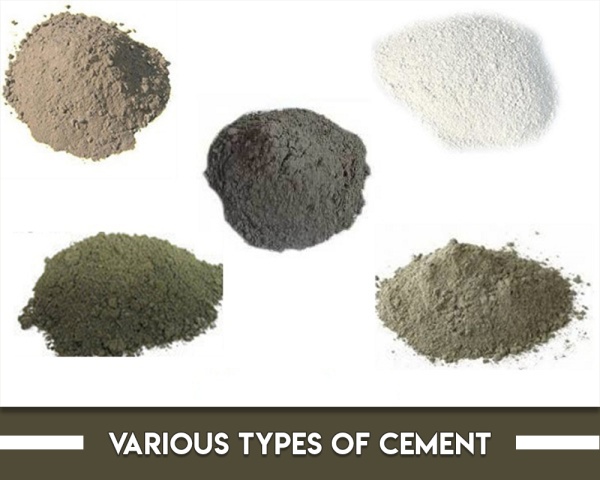There are numerous types of cement, with the most common being Ordinary Portland Cement (OPC) and Portland Pozzolana Cement (PPC). Cement is a crucial building material used in construction projects worldwide.
Different types of cement cater to various construction needs, enhancing strength and durability. Ordinary Portland Cement (OPC) is widely used due to its versatility. Portland Pozzolana Cement (PPC) is preferred for its enhanced durability and resistance to chemical attacks. Other types include Rapid Hardening Cement, Sulphate Resisting Cement, and White Cement, each serving specific purposes.
Choosing the right type of cement is essential for the success of any construction project. Understanding the characteristics and benefits of each type ensures optimal performance and longevity of structures.
Introduction To Cement Varieties
Cement is a crucial material in construction. It acts as a binder and holds structures together. There are various types of cement, each with unique properties. Understanding these varieties helps in selecting the right cement for specific projects.
The Role Of Cement In Construction
Cement plays a vital role in construction projects. It provides strength and durability. Cement is used in building foundations, walls, and bridges. It is also essential for roads and dams. Different types of cement meet different needs in construction.
Factors Influencing Cement Selection
Several factors influence the choice of cement. These include the type of structure, environmental conditions, and cost. Choosing the right cement ensures the longevity of the construction. Here are the key factors:
- Type of Structure: Different structures require different strengths.
- Environmental Conditions: Climate and exposure to chemicals affect cement choice.
- Cost: Budget constraints can influence the type of cement used.
Below is a table summarizing some common types of cement and their primary uses:
| Type of Cement | Primary Use |
|---|---|
| Ordinary Portland Cement (OPC) | General construction, roads, and bridges |
| Rapid Hardening Cement | Road repairs, early strength development |
| Portland Pozzolana Cement (PPC) | Marine structures, sewage works |
| White Cement | Decorative works, architectural beauty |
Ordinary Portland Cement (opc)
Ordinary Portland Cement (OPC) is the most common type of cement used in construction. It is known for its strength and durability. OPC is made from a mixture of limestone, clay, and gypsum. This type of cement sets and hardens quickly when mixed with water.
Opc Grade 33, 43, And 53
OPC comes in different grades based on its strength. The grades are 33, 43, and 53. Each grade is used for different types of construction work.
| Grade | Strength (MPa) | Common Uses |
|---|---|---|
| OPC Grade 33 | 33 MPa | Plastering, pathways, and low-rise buildings |
| OPC Grade 43 | 43 MPa | Residential buildings, commercial complexes, and bridges |
| OPC Grade 53 | 53 MPa | High-rise buildings, dams, and large infrastructure projects |
Common Uses Of Opc
OPC is versatile and is used in many construction projects. Here are some common uses:
- Concrete Structures: OPC is ideal for making concrete structures like beams, columns, and slabs.
- Plastering: It provides a smooth finish for walls and ceilings.
- Foundation: OPC is used for building strong foundations.
- Precast Concrete: It is used in making precast concrete products like pipes and blocks.
- Roads and Bridges: OPC ensures durability and strength for roads and bridges.
Choosing the right grade of OPC is important for your construction needs. Each grade has its unique benefits and applications.
Portland Pozzolana Cement (ppc)
Portland Pozzolana Cement (PPC) is a type of blended cement. It is made by mixing ordinary Portland cement with pozzolana materials. This cement is known for its durability and strength. It is widely used in various construction projects.
Pozzolana Materials And Their Benefits
Pozzolana materials are natural or artificial substances. They contain silica and alumina. These materials react with calcium hydroxide to form compounds that have cementitious properties.
- Natural pozzolanas are volcanic ash, pumice, and diatomaceous earth.
- Artificial pozzolanas include fly ash, silica fume, and blast furnace slag.
Using pozzolana materials in PPC offers several benefits:
- Improved durability: PPC has better resistance to chemicals.
- Lower heat of hydration: This makes it suitable for mass concreting.
- Reduced permeability: PPC helps in making structures more water-resistant.
Environmental Advantages Of PPC
Portland Pozzolana Cement is eco-friendly. It uses industrial waste materials like fly ash and slag. This helps in reducing landfill waste.
Producing PPC emits less carbon dioxide. It uses fewer natural resources. This makes it a sustainable choice for construction.
Here are the key environmental advantages:
| Benefit | Description |
|---|---|
| Reduced Carbon Footprint | Lower CO2 emissions during production. |
| Resource Efficiency | Utilizes industrial by-products. |
| Less Landfill Waste | Reduces waste by reusing materials. |
PPC is a smart choice for sustainable construction. It provides durability and environmental benefits.
Rapid Hardening Cement is a special type of cement. It gains strength faster than ordinary cement. This makes it ideal for projects needing quick completion.
Accelerated Setting Time
This cement has an accelerated setting time. It sets within just a few hours. This can be crucial for projects with tight deadlines.
Here are some key features of its setting time:
- Initial setting time: 30 minutes
- Final setting time: 600 minutes
Applications In Precast Industry
Rapid Hardening Cement is widely used in the precast industry. It helps in producing precast elements quickly.
Common applications include:
- Precast beams and columns
- Concrete pipes
- Wall panels
Using Rapid Hardening Cement in the precast industry offers several benefits:
| Benefit | Description |
|---|---|
| Quick Turnaround | Reduces production time, allowing faster project completion. |
| Early Strength | Achieves high strength in a short period. |
| Cost Efficiency | Decreases labor costs due to faster setting times. |
Low Heat Cement
Low Heat Cement is a specialized type of cement designed to reduce the heat generated during the hydration process. This type of cement is particularly useful in projects where controlling the temperature rise is crucial. It minimizes the risk of thermal cracking and enhances the durability of concrete structures.
Reduced Heat Of Hydration
Low Heat Cement is known for its reduced heat of hydration. The heat of hydration refers to the heat released during the chemical reaction between cement and water. In standard cement, this reaction can generate significant heat, leading to thermal stress and potential cracking. Low Heat Cement produces less heat, making it ideal for large-scale concrete pours.
This type of cement achieves a slower and more controlled hydration process. This helps in maintaining a stable temperature in the concrete structure. The composition of Low Heat Cement includes a lower percentage of tricalcium silicate (C3S) and an increased amount of dicalcium silicate (C2S). These adjustments in the chemical makeup help in reducing the heat generated during the hydration process.
Use In Massive Concrete Structures
Low Heat Cement is extensively used in massive concrete structures, where the heat generated can be significant. Examples include dams, large foundations, and thick concrete walls. In these applications, temperature control is critical to avoid cracking and ensure long-term durability.
- Dams
- Large foundations
- Thick concrete walls
Using Low Heat Cement in these structures helps in preventing thermal cracks. Thermal cracks occur due to temperature gradients within the concrete mass. By reducing the heat of hydration, Low Heat Cement ensures a more uniform temperature distribution. This reduces the risk of cracking and enhances the structural integrity.
| Application | Benefits |
|---|---|
| Dams | Prevents thermal cracking and ensures durability |
| Large Foundations | Maintains structural integrity |
| Thick Concrete Walls | Reduces risk of thermal stress |
Overall, Low Heat Cement is a crucial material for projects requiring temperature control. Its unique properties make it indispensable in the construction of massive concrete structures. By reducing the heat of hydration, it enhances the longevity and performance of these structures.
Sulfate Resisting Cement
Sulfate Resisting Cement is a specialized type of cement designed to withstand the aggressive effects of sulfate ions. These ions are often found in soil and water, posing a risk to concrete structures. This cement helps in enhancing the durability and lifespan of buildings and infrastructure exposed to sulfate-rich environments.
Protection Against Sulfate Attacks
Sulfate Resisting Cement provides exceptional protection against sulfate attacks. Sulfates cause concrete to expand and crack, leading to structural damage. This type of cement reduces the risk of these destructive reactions.
The main component responsible for this protection is the low tricalcium aluminate (C3A) content. A lower C3A content minimizes the reaction with sulfates, thereby protecting the concrete. This characteristic makes it the preferred choice for structures exposed to sulfate-rich conditions.
Construction In Sulfate-rich Soils
Using Sulfate Resisting Cement in sulfate-rich soils ensures the longevity and integrity of the construction. These soils often contain high levels of sulfates, which can be detrimental to ordinary cement.
This type of cement is ideal for foundations, retaining walls, and basements built in such environments. It is also suitable for marine structures like piers and docks, which are exposed to seawater containing sulfates.
The table below provides a quick comparison of the benefits of using Sulfate Resisting Cement:
| Feature | Benefit |
|---|---|
| Low C3A Content | Reduces sulfate reactions |
| Enhanced Durability | Longer lifespan of structures |
| Suitable for Marine Use | Resistant to seawater sulfates |
In summary, Sulfate Resisting Cement is essential for construction in areas with high sulfate presence. It ensures that structures remain strong and durable over time.
White Cement
White cement is a type of cement that is white in color. It is made from raw materials that are low in iron and magnesium. These elements give it a pure white color. White cement is known for its aesthetic and decorative applications in architecture.
Manufacturing Of White Cement
The manufacturing process of white cement is similar to that of gray cement. The main difference lies in the raw materials used.
- Raw Materials: White cement uses raw materials with low iron and magnesium content.
- Mixing: The raw materials are mixed together to form a homogenous mixture.
- Heating: This mixture is then heated in a kiln at high temperatures.
- Cooling: The heated mixture is cooled to form clinker.
- Grinding: The clinker is ground to produce fine white cement powder.
| Step | Description |
|---|---|
| Raw Materials | Low iron and magnesium content |
| Mixing | Homogenous mixture formation |
| Heating | High temperature in a kiln |
| Cooling | Formation of clinker |
| Grinding | Fine white cement powder |
Aesthetic Applications In Architecture
White cement is popular in architectural applications due to its bright color. It enhances the beauty and elegance of buildings.
- Exterior Facades: White cement is used for smooth and clean exterior walls.
- Decorative Concrete: It is often used in decorative concrete products like statues and garden ornaments.
- Flooring: It is used in flooring to create beautiful, reflective surfaces.
- Interior Design: White cement is used in interiors for a modern and sleek look.
White cement has a high demand in the market due to its unique properties and aesthetic appeal. It is an essential material in modern architecture.

Credit: www.99acres.com
High Alumina Cement
High Alumina Cement is a special type of cement. It has a high content of alumina, which makes it unique. It is also known as HAC. This type of cement is famous for its rapid hardening properties.
Composition And Properties
High Alumina Cement is composed of limestone and bauxite. The main ingredient is alumina, which is present in large quantities. The cement is known for its quick-setting feature. It can set and harden in less than 24 hours. This makes it ideal for emergency repairs.
It has excellent resistance to chemical attacks. This makes it suitable for structures exposed to harsh chemicals. Another key property is its high temperature resistance. It can withstand temperatures up to 1500°C.
Usage In Refractory Concretes
High Alumina Cement is widely used in refractory concretes. Refractory concretes are designed to withstand high temperatures. These concretes are used in furnaces, kilns, and incinerators. They are essential in the steel and glass industries.
Using High Alumina Cement in refractory concretes ensures durability. It also provides better thermal efficiency. This is crucial in industrial applications. The cement’s quick-setting feature also reduces downtime during repairs. This ensures that industrial operations continue smoothly.
| Property | High Alumina Cement |
|---|---|
| Setting Time | Less than 24 hours |
| Chemical Resistance | High |
| Temperature Resistance | Up to 1500°C |
High Alumina Cement is a versatile material. Its unique properties make it suitable for many applications. Whether for quick repairs or industrial use, it stands out as an efficient solution.
Blended Cements And Their Types
Blended cements are created by mixing ordinary portland cement (OPC) with supplementary cementitious materials. These materials enhance the properties of the cement. Blended cements improve durability, reduce carbon footprint, and are cost-effective. They are widely used in construction projects worldwide.
Fly Ash-based Cements
Fly ash-based cements are made by blending fly ash with ordinary portland cement. Fly ash is a by-product of coal combustion in power plants. It is rich in silica, alumina, and iron. These elements improve the strength and durability of the cement.
Some key benefits of fly ash-based cements include:
- Increased workability – Easier to mix and pour.
- Enhanced durability – Better resistance to chemical attacks.
- Reduced heat of hydration – Ideal for mass concrete structures.
- Eco-friendly – Utilizes industrial waste, reducing environmental impact.
Slag-based Cements
Slag-based cements are produced by blending ground granulated blast furnace slag (GGBFS) with ordinary portland cement. GGBFS is a by-product of the steel manufacturing process. It contains calcium, silica, and alumina, which enhance the cement’s properties.
Here are some advantages of slag-based cements:
- Improved resistance to sulfates – Ideal for harsh environments.
- Lower permeability – Reduces the risk of corrosion in reinforced concrete.
- Better long-term strength – Gradual increase in strength over time.
- Environmental benefits – Utilizes waste materials, reducing carbon footprint.
| Type | Key Benefits | Applications |
|---|---|---|
| Fly Ash-Based Cements | Increased workability, enhanced durability, reduced heat of hydration, eco-friendly | Mass concrete structures, general construction, roads |
| Slag-Based Cements | Improved resistance to sulfates, lower permeability, better long-term strength, environmental benefits | Harsh environments, reinforced concrete structures, marine construction |
Specialty Cements For Modern Applications
Modern construction requires advanced materials. Specialty cements fulfill this need. They offer unique properties for specific applications. Let’s explore two notable types: Oil Well Cement and Hydrophobic Cement.
Oil Well Cement For Petroleum Industry
Oil Well Cement is essential in the petroleum industry. It seals oil wells and prevents leaks. This cement withstands high temperatures and pressures. It ensures safety in deep drilling operations.
Types of Oil Well Cement:
- Class A: Used at depths up to 6,000 feet.
- Class G: Suitable for deeper wells and harsher conditions.
| Class | Application Depth | Properties |
|---|---|---|
| Class A | Up to 6,000 feet | General use |
| Class G | Deeper wells | High resistance to pressure |
Hydrophobic Cement And Its Uses
Hydrophobic Cement repels water. It is ideal for waterlogged and humid environments. This cement has special additives that prevent moisture absorption.
Uses of Hydrophobic Cement:
- Marine construction
- Underwater structures
- Basement walls
Hydrophobic Cement keeps structures dry. It enhances durability and longevity. This cement is a go-to choice for challenging environments.
Choosing The Right Cement
Selecting the right cement is crucial for any construction project. Different types of cement offer varied properties. These properties impact strength, durability, and environmental impact. Knowing these differences helps in making informed decisions. Below, we explore performance characteristics and economic and environmental considerations.
Comparing Performance Characteristics
Performance characteristics vary widely among cement types. Here’s a quick comparison:
| Cement Type | Strength | Setting Time | Durability |
|---|---|---|---|
| Ordinary Portland Cement (OPC) | High | Fast | Moderate |
| Portland Pozzolana Cement (PPC) | Moderate | Slow | High |
| Rapid Hardening Cement | Very High | Very Fast | Moderate |
| Sulfate Resistant Cement | Moderate | Moderate | High |
Ordinary Portland Cement (OPC) is ideal for general construction. Portland Pozzolana Cement (PPC) is preferred for structures exposed to water. Rapid Hardening Cement is best for urgent projects. Sulfate Resistant Cement is suitable for marine environments.
Economic And Environmental Considerations
Economic and environmental factors play a significant role in choosing cement. Here are some points to consider:
- Cost: Some cements are more expensive than others. Rapid Hardening Cement costs more but saves time.
- Availability: Ensure the cement type is available in your region.
- Environmental Impact: PPC has a lower carbon footprint. It uses industrial by-products.
- Waste Reduction: Some cements reduce waste by using recycled materials.
Considering these factors helps in making a balanced choice. Choose a cement that fits both your budget and environmental goals.

Credit: gharpedia.com
Conclusion: The Future Of Cement Technology
The future of cement technology looks promising. Innovations continue to shape the industry. Sustainable practices are becoming more prevalent. These changes aim to reduce environmental impact while improving performance.
Innovations In Cement Production
Cement production is evolving. New techniques are being developed. These aim to enhance efficiency and quality. Below are some key innovations:
- 3D Printing: This technology allows for precise cement structures. It reduces waste and speeds up construction.
- Carbon Capture: This process captures CO2 emissions during production. It helps in reducing the carbon footprint.
- Alternative Fuels: Using waste materials as fuel is gaining traction. It lowers production costs and reduces emissions.
Sustainable Practices In Cement Use
Sustainability in cement use is crucial. Builders and manufacturers are adopting greener methods. This not only helps the environment but also saves costs. Here are some sustainable practices:
- Recycled Materials: Using recycled aggregates reduces the need for new raw materials.
- Green Cement: This type of cement uses less energy to produce. It also emits fewer pollutants.
- Energy-Efficient Construction: Techniques that reduce energy consumption during construction are becoming popular.
These advancements are setting new standards. The industry is moving towards a greener future. The next steps involve adopting these practices widely. This will ensure a sustainable and efficient cement industry.
How Does Solvent Cement Compare to Other Types of Cement?
When it comes to bonding PVC pipes, solvent cement bonding secrets unravelled reveal that solvent cement is the top choice. Unlike other types of cement, solvent cement creates a strong and durable bond that can withstand the test of time and pressure. Its quick drying time and ease of use make it a popular choice for many plumbing and construction projects.
Frequently Asked Questions
What Are Three Types Of Cement?
The three types of cement are Ordinary Portland Cement (OPC), Portland Pozzolana Cement (PPC), and Rapid Hardening Cement.
What Are The 3 Grades Of Cement?
The three grades of cement are 33 Grade, 43 Grade, and 53 Grade. These numbers indicate the compressive strength of the cement in megapascals (MPa) after 28 days. Each grade is suitable for different construction needs and applications.
What Is Type 5 Cement Used For?
Type 5 cement is used in environments with high sulfate exposure. It offers resistance to sulfate attack, ensuring durability. Ideal for foundations, sewage systems, and coastal structures.
What Is Type 3 Cement Used For?
Type 3 cement is used for fast-setting concrete. It is ideal for cold weather construction and early-strength applications.
Conclusion
Understanding the different types of cement is crucial for any construction project. Each type offers unique properties and benefits. Selecting the right cement ensures durability and strength. Always consult a professional to determine the best option for your needs. Keep these insights in mind for your next building endeavor.
{ “@context”: “https://schema.org”, “@type”: “FAQPage”, “mainEntity”: [ { “@type”: “Question”, “name”: “What are three types of cement?”, “acceptedAnswer”: { “@type”: “Answer”, “text”: “The three types of cement are Ordinary Portland Cement (OPC), Portland Pozzolana Cement (PPC), and Rapid Hardening Cement.” } } , { “@type”: “Question”, “name”: “What are the 3 grades of cement?”, “acceptedAnswer”: { “@type”: “Answer”, “text”: “The three grades of cement are 33 Grade, 43 Grade, and 53 Grade. These numbers indicate the compressive strength of the cement in megapascals (MPa) after 28 days. Each grade is suitable for different construction needs and applications.” } } , { “@type”: “Question”, “name”: “What is type 5 cement used for?”, “acceptedAnswer”: { “@type”: “Answer”, “text”: “Type 5 cement is used in environments with high sulfate exposure. It offers resistance to sulfate attack, ensuring durability. Ideal for foundations, sewage systems, and coastal structures.” } } , { “@type”: “Question”, “name”: “What is Type 3 cement used for?”, “acceptedAnswer”: { “@type”: “Answer”, “text”: “Type 3 cement is used for fast-setting concrete. It is ideal for cold weather construction and early-strength applications.” } } ] }







